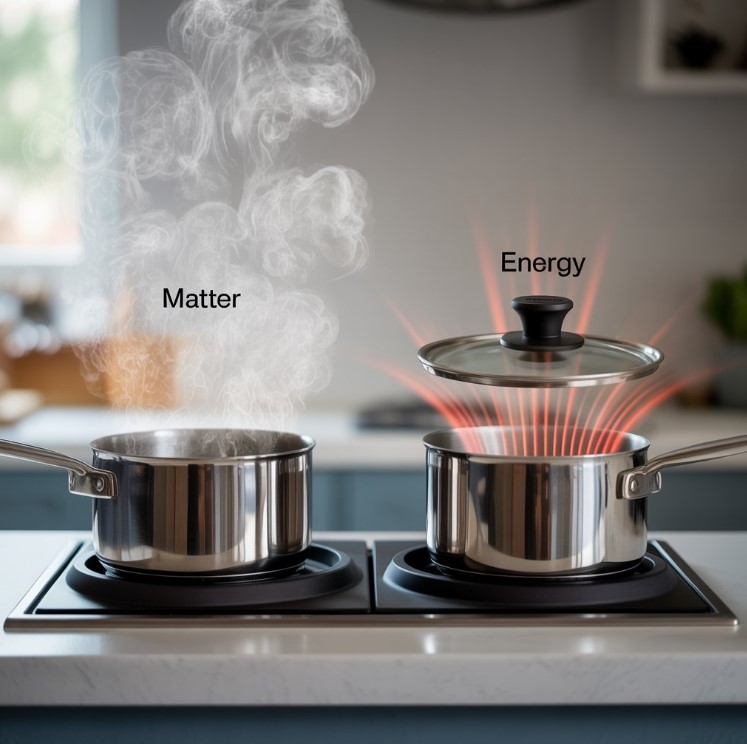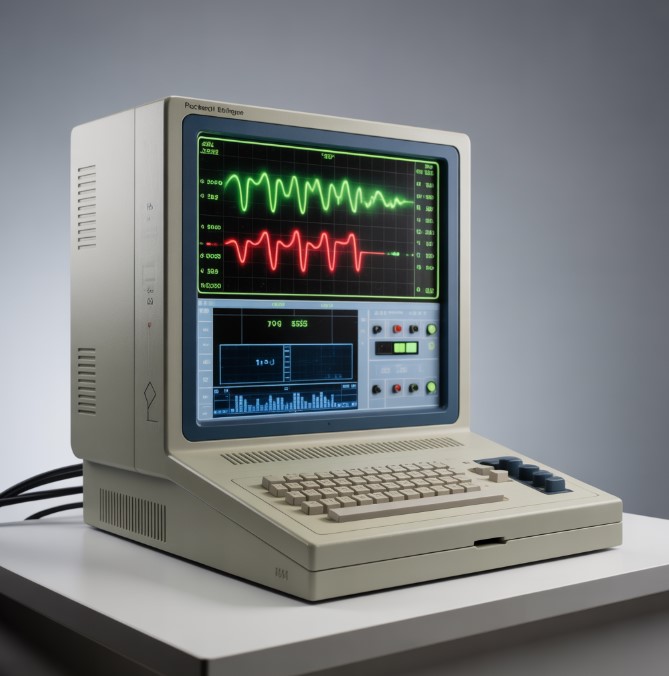Contents
Understanding a closed system in thermodynamics is foundational to analyzing how devices work, as it defines a system that allows an exchange of energy but not an exchange of matter with the system and surroundings.
What is a Closed System in Thermodynamics?
In the field of thermodynamics, the universe is divided into two parts for analysis: the system and surroundings. The system is the specific part of the universe we are studying, while the surroundings are everything else outside that system. The line separating them is called the boundary. Based on how this boundary interacts with the surroundings, we can classify systems into three types.
A closed system is defined by a boundary that prevents the exchange of matter but permits the exchange of energy. In simple words, a closed system is a system that can exchange energy but not matter. This means that the total mass inside the closed system remains constant. For this reason, closed systems are also frequently referred to as control mass systems or non-flow systems.
Key Characteristics of Closed Systems
To better understand closed systems, consider their primary characteristics:
- Fixed Mass: The defining feature of a closed system is that no matter can cross its boundary. The amount of matter within the system is fixed. This is the main point of difference between open and closed system classifications.
- Energy Transfer: A closed system can have an exchange of energy with its surroundings. This energy can be in the form of heat or work. For example, heat can be added to the system, or the system can do work on its surroundings. This is a crucial aspect of energy conversion in closed systems.
- Variable Boundary: The boundary of a closed system does not have to be fixed in position. It can move, expand, or contract. A classic example is a gas in a cylinder fitted with a movable piston.
Visualizing the Difference: Open System vs. Closed System
To clarify the concept, it’s helpful to compare a closed system directly with an open system. An open system allows both the exchange of energy and the exchange of matter across its boundary.

| Feature | Open System | Closed System |
|---|---|---|
| Exchange of Matter | Yes, matter can cross the boundary. | No, matter cannot cross the boundary. |
| Exchange of Energy | Yes, energy can cross the boundary. | Yes, energy can cross the boundary. |
| Mass Inside System | Variable | Constant (Control Mass) |
| Common Example | An open pot of boiling water. | A sealed can of soda. |
| Technical Name | Control Volume System | Control Mass Systems or non-flow systems |
Examples of Closed Systems in Real Life
Many everyday objects and engineering processes can be analyzed as closed systems. Understanding these examples of closed systems in real life helps solidify the concept.
- Boiling Soup in a Closed Lid saucepan
The act of boiling soup in a closed lid saucepan is a classic example of a closed system.- System and Surroundings: The system is the soup and water vapor inside the saucepan. The surroundings are the stove and the kitchen environment.
- Exchange of Energy: The stove transfers heat energy into the saucepan, causing the soup to boil. Heat also radiates from the saucepan’s outer surfaces into the surroundings.
- Exchange of Matter: The tight lid prevents the steam (matter) from escaping. Therefore, there is no exchange of matter. It is important to note that no real-world system is perfectly closed, as a tiny amount of gas might escape, but for thermodynamic analysis, it is an excellent approximation of a closed system.
- A Sealed Can of Soda
A cold, unopened can of soda is another straightforward example of a closed system.- System and Surroundings: The system is the soda and carbon dioxide gas inside the can. The surroundings are the room or refrigerator where it is located.
- Exchange of Energy: If you place the cold can on a table, it will absorb heat energy from the surroundings until it reaches room temperature.
- Exchange of Matter: The can is hermetically sealed, prohibiting any liquid or gas from entering or leaving. This makes it a clear closed system.
- Piston Cylinder Arrangements Without Valve
In mechanical engineering, piston cylinder arrangements without valve systems are fundamental examples of a closed system.- System and Surroundings: The system is the gas trapped inside the cylinder, under the piston. The surroundings are everything outside the cylinder.
- Exchange of Energy: Heat can be added to the cylinder, causing the gas to expand and push the piston up, doing work on the surroundings. This demonstrates energy conversion in closed systems (thermal to mechanical).
- Exchange of Matter: Since there are no valves, the gas cannot escape, and no new gas can enter. The mass of the gas remains constant, qualifying it as one of the control mass systems or non-flow systems.
- Rankine Cycle as a Closed System
The Rankine cycle as a closed system is a more abstract but crucial example from power generation thermodynamics.- System and Surroundings: The system is the working fluid (usually water/steam) that circulates through the four components: pump, boiler, turbine, and condenser. The surroundings are the heat source (like a furnace) and the heat sink (like a cooling tower).
- Exchange of Energy: Energy is added as heat in the boiler and removed as heat in the condenser. The system produces work in the turbine and consumes work in the pump.
- Exchange of Matter: The same working fluid is continuously circulated in a loop. It never leaves the system, making the entire cycle a perfect closed system.
- A Terrarium
A sealed glass terrarium used for growing plants is a biological example of a closed system.- System and Surroundings: The system consists of the plants, soil, air, and water vapor inside the glass container. The surroundings are the room where the terrarium is placed.
- Exchange of Energy: Light energy from the sun or an artificial lamp enters the terrarium, allowing the plants to perform photosynthesis. Heat energy also transfers in and out through the glass.
- Exchange of Matter: The sealed container prevents the exchange of matter. Water evaporates and condenses inside, creating a self-sustaining water cycle. Oxygen and carbon dioxide are cycled by the plants.
Common Misconceptions and Nuanced Cases: FAQ
Certain devices are often mistaken for closed systems. Clarifying these cases deepens our understanding of system boundaries.
Is a pressure cooker a closed system?
This is a common point of confusion. A pressure cooker is designed to operate at a specific pressure. To maintain this pressure, it has a valve that releases steam (matter) when the pressure gets too high. Because it is designed to have an exchange of matter with the surroundings during operation, a pressure cooker is technically an open system, not a closed system. Before it starts releasing steam, or after it has cooled down, it can be approximated as a closed system, but not during its main cooking function.
Is an air conditioner a closed system?
This question highlights the importance of defining the system boundary. The answer is both yes and no, depending on what part you analyze.
- The Refrigerant Loop: The sealed copper tubing containing the refrigerant is an excellent example of a closed system. The refrigerant continuously circulates, absorbing and releasing heat (an exchange of energy) but never leaving the tubes (no exchange of matter). This is the part engineers analyze using closed system principles.
- The Entire Appliance: The complete air conditioner unit is an open system. It draws warm air (matter) from the room, cools it, and pushes cool air (matter) back out. Since there is a mass flow across its boundary, the overall device is an open system.
What is energy conversion in closed systems?
Energy conversion in closed systems is a fundamental process. Since matter cannot enter or leave, any change in the system’s internal energy is a direct result of heat or work crossing its boundary. For example:
- In a light bulb (closed system), electrical energy enters and is converted into light and heat energy, which then exit into the surroundings.
- In the piston cylinder arrangements without valve, thermal energy (heat) added to the gas is converted into mechanical energy (work) as the piston moves.
The Importance of Closed Systems in Thermodynamics
The concept of the closed system is vital because it simplifies analysis. By knowing that the mass is constant (control mass systems or non-flow systems), scientists and engineers can apply specific laws of thermodynamics, such as the First Law for a Closed System, to precisely calculate changes in energy, work, and heat. This is essential for designing everything from engines to power plants and understanding countless natural phenomena.
Summary of Thermodynamic Systems
This table provides a final review of the key difference between open and closed system classifications, along with the isolated system.
| System Type | Allows Exchange of Energy? | Allows Exchange of Matter? | Example |
|---|---|---|---|
| Open System | Yes | Yes | A cup of hot coffee |
| Closed System | Yes | No | A sealed water bottle |
| Isolated System | No | No | An idealized thermos flask |
By consistently applying the principles of the closed system, one can accurately model and predict the behavior of countless physical processes, making it a cornerstone of thermodynamics.







